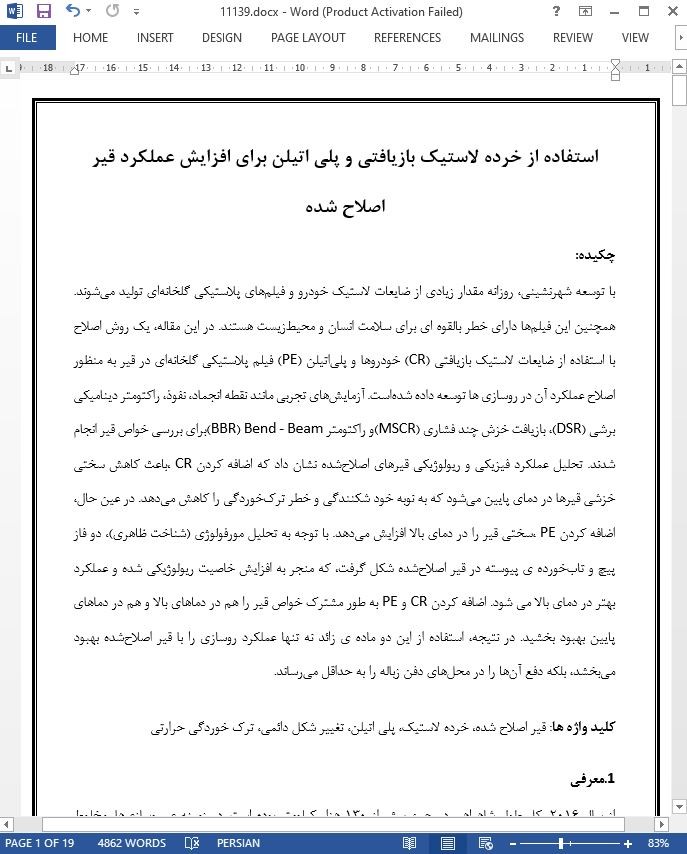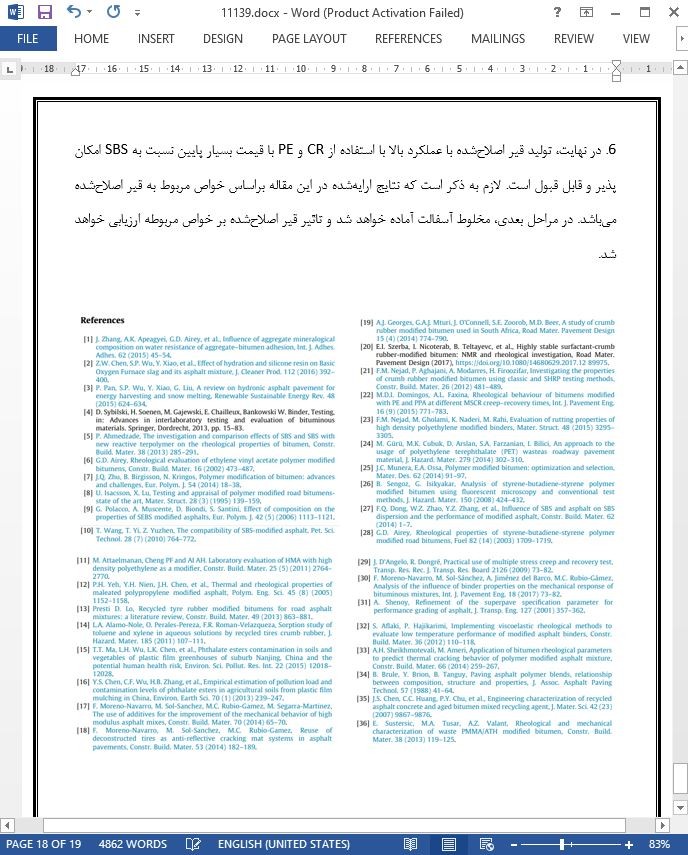
استفاده از خرده لاستیک بازیافتی و پل اتیلن برای افزایش عملکرد قیر اصلاح شده
چکیده
با توسعه شهرنشینی، روزانه مقدار زیادی از ضایعات لاستیک خودرو و فیلمهای پلاستیکی گلخانهای تولید میشوند. همچنین این فیلمها دارای خطر بالقوه ای برای سلامت انسان و محیطزیست هستند. در این مقاله، یک روش اصلاح با استفاده از ضایعات لاستیک بازیافتی (CR) خودروها و پلیاتیلن (PE) فیلم پلاستیکی گلخانهای در قیر به منظور اصلاح عملکرد آن در روسازی ها توسعه داده شدهاست. آزمایشهای تجربی مانند نقطه انجماد، نفوذ، راکتومتر دینامیکی برشی (DSR)، بازیافت خزش چند فشاری (MSCR)و راکتومتر Bend - Beam (BBR)برای بررسی خواص قیر انجام شدند. تحلیل عملکرد فیزیکی و ریولوژیکی قیرهای اصلاحشده نشان داد که اضافه کردن CR ،باعث کاهش سختی خزشی قیرها در دمای پایین میشود که به نوبه خود شکنندگی و خطر ترکخوردگی را کاهش میدهد. در عین حال، اضافه کردن PE ،سختی قیر را در دمای بالا افزایش میدهد. با توجه به تحلیل مورفولوژی (شناخت ظاهری)، دو فاز پیچ و تابخورده ی پیوسته در قیر اصلاحشده شکل گرفت، که منجر به افزایش خاصیت ریولوژیکی شده و عملکرد بهتر در دمای بالا می شود. اضافه کردن CR و PE به طور مشترک خواص قیر را هم در دماهای بالا و هم در دماهای پایین بهبود بخشید. در نتیجه، استفاده از این دو ماده ی زائد نه تنها عملکرد روسازی را با قیر اصلاحشده بهبود میبخشد، بلکه دفع آنها را در محلهای دفن زباله را به حداقل میرساند.
1.معرفی
از سال ۲۰۱۶، کل طول شاهراهی در چین بیش از ۱۳۰ هزار کیلومتر بوده است. در زمینه ی روسازیها، مخلوط آسفالتی، ماده ی غالب برای روسازیهای سطحی است. مخلوط آسفالتی در دماهای بالا با مخلوط کردن نسبت از پیش تعیینشده سنگ دانهها (درشت و ریز)، قیر و پرکننده، پس از فرآیند آسفالت کردن و تراکم برای ایجاد یک روسازی انعطافپذیر تولید میشود [ ۱ ]. خواص فیزیکی و ریولوژیکی خمیرهای قیری نقش مهمی در عملکرد مخلوطهای آسفالتی ایفا میکنند. سیبیلسکی و همکارانش گزارش دادند که خواص قیر تقریبا سهمی به میزلن ۴۰ % درمقاومت شیارافتادگی(rutting ) روسازی آسفالتی دارند [ ۴ ]. در مناطق با دمای بالا، شیارافتادگی (تغییر شکل دایمی)یک خرابی عمده روسازیهای آسفالتی است که در آن مخلوطهای قرار گرفته در مسیرهای چرخ ماشین به منظور تشکیل یک شیار( rut) ناشی از یک وسیله نقلیه سنگین، جمع شدهاند. بهبود خواص قیر امری مهم است چرا که با افزایش مقدار بارگذاری ترافیکی و یا حمله ی محیط مهاجم نباید دچار خرابی شود.
6. نتایج
استفاده کردن از CR بازیافتی و PE به عنوان عوامل اصلاح برای تهیه قیر اصلاحشده در این مطالعه مورد بررسی قرار گرفتهاست. خواص قیرهای اصلاحشده در دماهای بالا و پایین با استفاده از آزمایشهای فیزیکی و اندازهگیری خواص رئولوژیکی مورد ارزیابی قرار گرفت. برخی از یافتههای مهم را می توان به صورت زیر بیان کرد:
1. براساس تصاویر FM، مورفولوژی (شناخت ظاهری) فازی، یک فاز قیر پیوسته با ذرات پلیمر پراکنده با اضافه کردن یک عامل واحد را نشان میدهد. با اضافه شدن CR و PE تحت اصلاح یکپارچه، یک فاز پلیمری تقریبا پیوسته ظاهر شد و در نهایت دو فاز پیچیده پیوسته را شکل داد. تشکیل این دو فاز درون قفلشده، کارایی بهبود یافته در دمای بالا را تایید میکند.
Abstract
With the development of urbanization, a huge amount of wasted vehicle tyre and wasted green house plastic film are generated everyday and they have a potential risk for human health and environment. In this article, an integrated modification method was developed by proportionally using recycled crumb rubber (CR) from vehicle tyre and polyethylene (PE) from wasted green house plastic film in the bitumen in order to modify its functioning in pavements. Experimental tests such as Softening point, Penetration, Dynamic Shear Rheometer (DSR), Multiple Stress Creep Recovery (MSCR) and Bending-Beam Rheometer (BBR) were carried out in comparison with the bitumen properties. Analysis on physical and rheological performance of modified bitumen binders indicated the addition of CR decreased the bitumen creep stiffness at low temperature which in turn reduced the brittleness and cracking risk. Meanwhile, the addition of PE increased the bitumen stiffness at high temperature. According to the morphology analysis, two continuous twisted phases were formed in the modified bitumen, which indicated enhanced rheological property and high-temperature performance. The addition of CR and PE cooperatively improved the bitumen properties at both high and low temperatures. Consequently, the utilization of these two waste materials not only improved the pavement performance with the modified bitumen, but also minimized their disposal at landfills.
1. Introduction
Since 2016, total expressway length in China is over 130 thousand km. In the field of pavements, the asphalt mixture is the dominant material for surface paving course. Asphalt mixture is produced at high temperatures by mixing predetermined ratio of aggregates (coarse and fine), bitumen and filler, after paving and compaction process to form a flexible pavement [1]. The physical and rheological properties of bituminous binders play an important role in the performance of asphalt mixtures [2,3]. Sybilski et al. reported that bitumen properties have approximately a 40% contribution to the rutting resistance of asphalt pavement [4]. In high-temperature regions, rutting (permanent deformation) is a major distress of asphalt pavements, where mixtures placed in the wheel paths compact to form a groove or rut due to a heavy vehicle. It is important to improve the bitumen properties so as to accommodate increasing traffic loading and environmental attack.
6. Conclusions
Utilization of recycled CR and PE as modifying agents to prepare the modified bitumen has been investigated in this study. Properties of modified bitumen at both high and low temperatures were evaluated by using conventional physical tests and rheological measurements. Some major findings can be given below:
1) Based on the FM images, the phase morphology shows a continuous bitumen phase with dispersed polymer particles by adding a single agent. With the addition of CR and PE under integrate modification, a nearly continuous polymer phase was appeared and finally formed two continuous twisted phases. The formation of these two interlocked phases verify the improved high-temperature performance.
چکیده
1.معرفی
2. مواد و آمادهسازی نمونه
1.2. مواد
2.2. آمادهسازی نمونه قیر اصلاحشده
3.شناخت ظاهری
1.3. ارزیابی شناخت ظاهری
2.3. آزمایش های رایج قیر
3.3. ازمایشهای sweep دما
4.3. آزمایش های MSCR
5.3. ازمایش رایومتر Bend – Beam:
4- نتایج و بحث
1.4. ارزیابی شناخت ظاهری
2.4. خواص فیزیکی مرسوم
3.4. نتایج sweep دما در دماهای بالا
4.4. نتایج ازمایش MSCR
5.4. نتایج ازمایش BBR
5. تحلیل مزیت اقتصادی
6.نتایج
Abstract
1. Introduction
2. Materials and sample preparation
2.1. Materials
2.2. Sample preparation of modified bitumen
3. Methodology
3.1. Morphology evaluation
3.2. Conventional bitumen tests
3.3. Temperature sweep tests
3.4. MSCR tests
3.5. Bending-Beam Rheometer tests
4. Results and discussion
4.1. Morphology evaluations
4.2. Conventional physical properties
4.3. Temperature sweep results at high temperatures
4.4. MSCR test results
4.5. BBR test results
5. Economic benefit analysis
6. Conclusions
- ترجمه فارسی مقاله با فرمت ورد (word) با قابلیت ویرایش، بدون آرم سایت ای ترجمه
- ترجمه فارسی مقاله با فرمت pdf، بدون آرم سایت ای ترجمه



